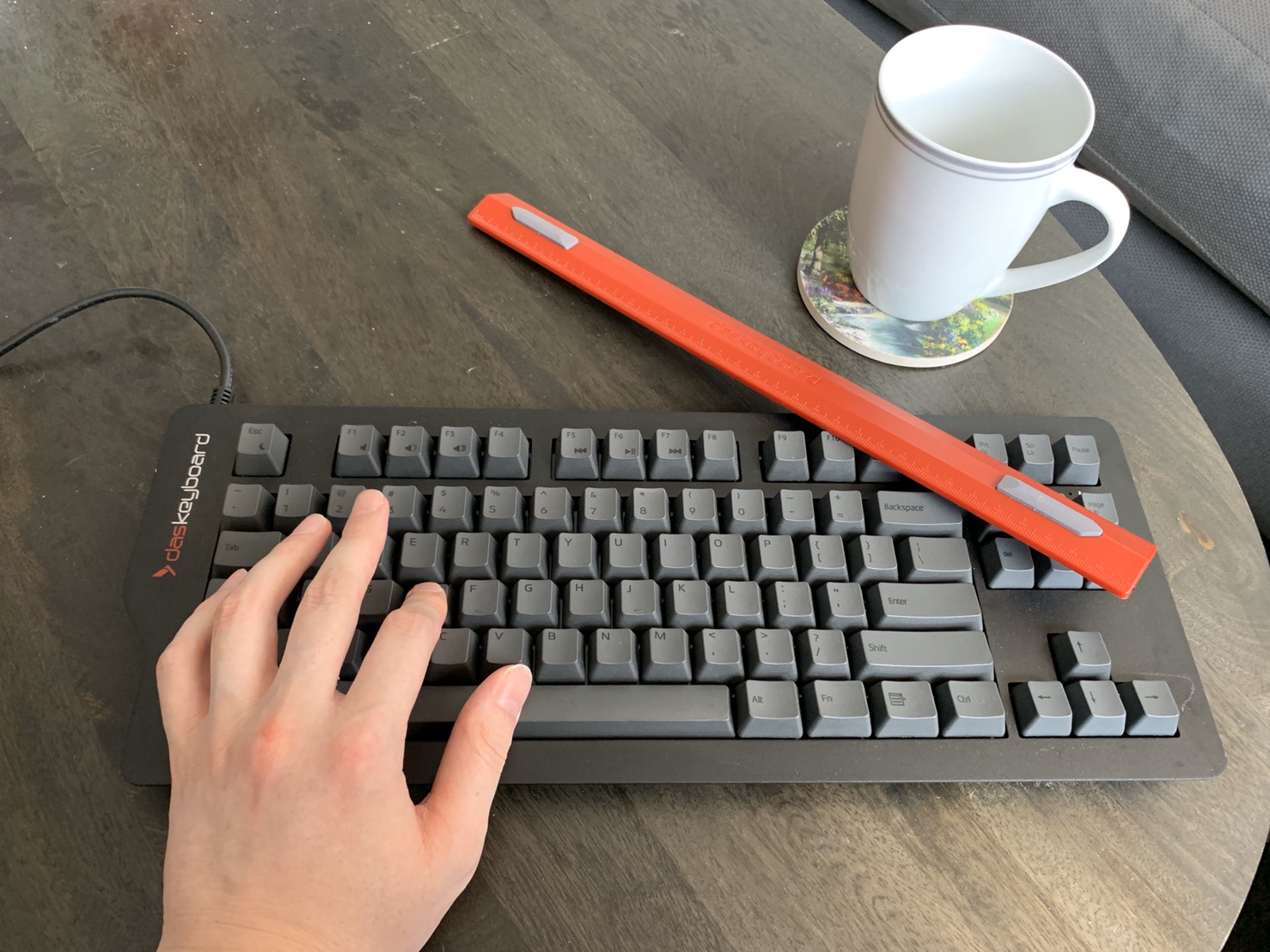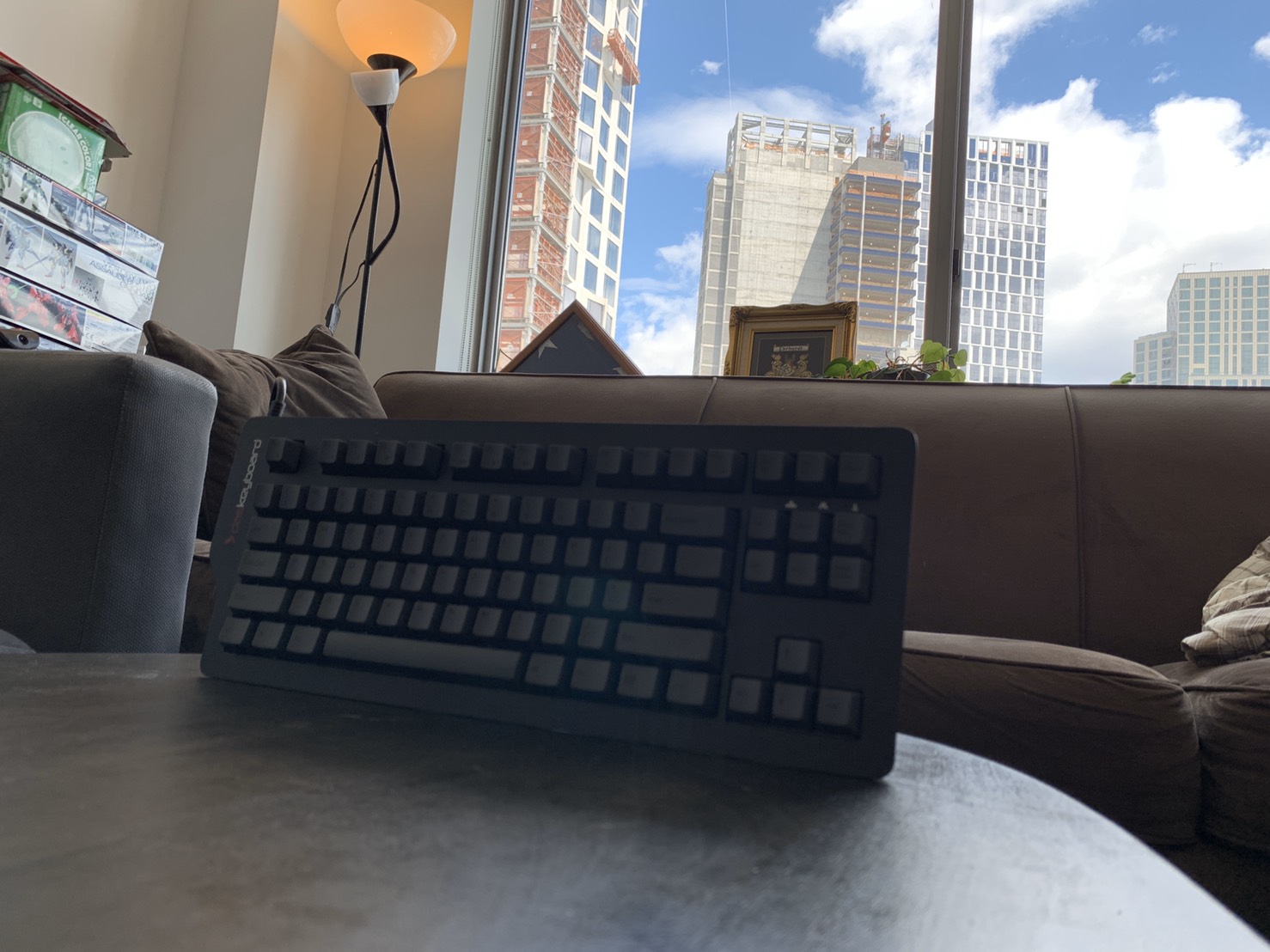Tom's Hardware Verdict
The Das Keyboard 4C TKL leverages a classy, minimalist design with strong build quality and tactile Cherry MX Brown switches. Perfect for typing and work, this professional keyboard lacks features gamers would prefer.
Pros
- +
Comfortable keyboard for typing
- +
Strong build quality with aluminum top panel, PBT keycaps
- +
Classy, subdued design
- +
Built-in USB 2.0 hub
Cons
- -
No onboard memory
- -
No dedicated media keys
Why you can trust Tom's Hardware
Das Keyboard’s 4C TKL keyboard ($139) offers mechanical fans a tenkeyless (no numpad) design. An update to the Das Keyboard 4C Professional released in 2015, the 4C TKL features a professional, compact design and a unique "footbar" that doubles as a ruler.
If you like the quiet, yet tactile feel of Cherry MX Brown switches and want a keyboard for typing first and entertainment second, the Das Keyboard 4C TKL more than fits the bill. However, with a muted aesthetic and lack of software extras, it isn’t versatile enough to compete with the best gaming keyboards.
Das Keyboard 4C TKL Specs
| Switches | Cherry MX Brown |
|---|---|
| Lighting | No |
| Onboard Storage | No |
| Media Keys | Yes, with Fn |
| Game Mode | Yes |
| Interface | USB 2.0 |
| Cable | 6.5 feet (1.98m) USB Type-A |
| Additional Ports | 2x USB Type-A |
| Key Caps | PBT |
| Construction | Aluminum top panel, plastic bottom |
| Software | None |
| Dimension (WxDxH) | 15.5 x 6 x 1.1 inches (393 x 152 x 28mm) without footbar |
| Weight | 2.5 pounds (1,134g) |
| Warranty | 1 year limited |
| Extra | 1x ruler footbar |
Design of Das Keyboard 4C TKL
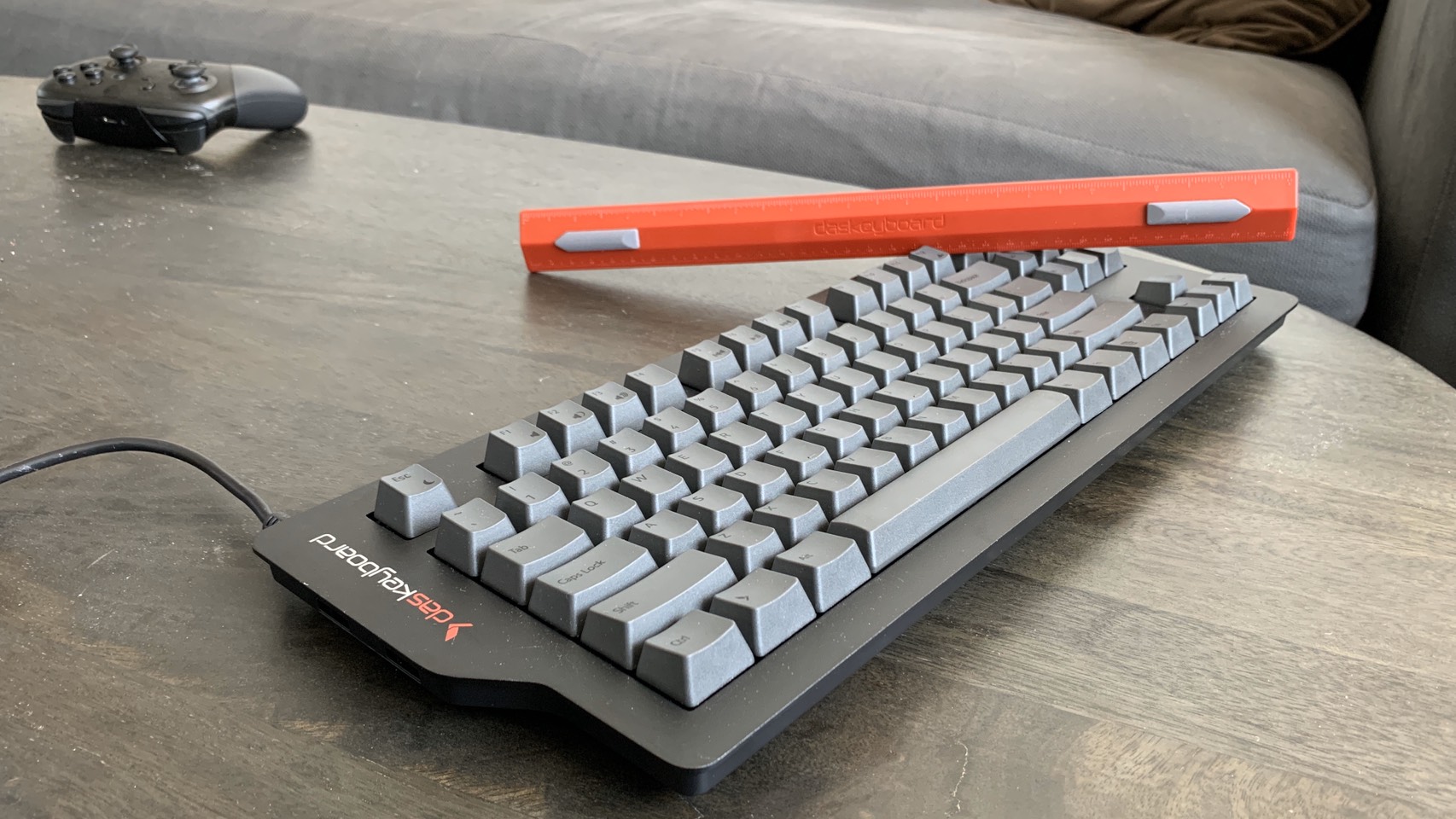

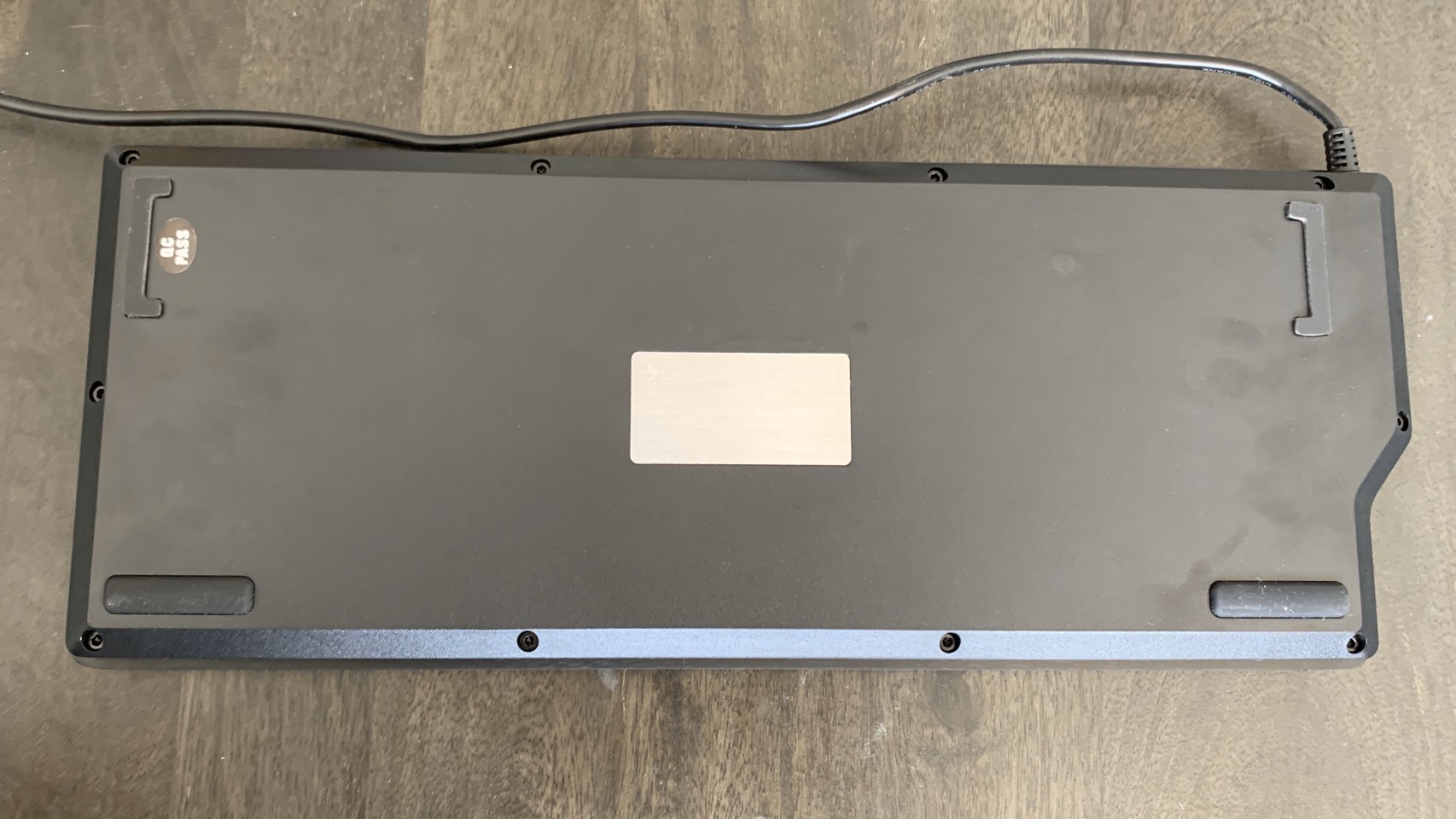
Das Keyboard’s name brings to mind a slick, feature-forward German sports car, and that’s exactly the aesthetic the 4C TKL keyboard achieves. This is a 15.5 x 6 x 1.1-inch tenkeyless design centered on subdued, charcoal-colored keycaps and a black aluminum top panel. With the 4C TKL, Das Keyboard seemingly prioritized class and build quality, but don’t think it’s boring either. A flash of red and white via the logo printed on the left side’s USB 2.0 hub cover lends the clacker a sense of exclusivity.
The removable footbar along the keyboard’s bottom adds another splash of red, plus the unique ability to double as a ruler. There’s also a slight shimmering effect on the PBT keycaps that gives them a sense of extravagance without going far enough to look like glitter.
The Arial-like black font on the Das Keyboard 4C TKL’s keycaps continues this aesthetic, but can unfortunately be hard to spot on the gray surface. A lack of RGB or backlighting only exacerbates this issue, cementing this as a keyboard more fit for a boardroom or office than a dimly-lit gamer den.
Of course, none of this is new for Das Keyboard, which has similar designs across its whole lineup. Missing here are the audio control wheel and dedicated media buttons you'll find on keyboards like the full-sized Das Keyboard 4Q. Still, at $139, the Das Keyboard 4C TKL is plenty suitable, and perhaps preferable, for those who don’t like RGB, while coming in cheaper than the 4Q’s $199 price tag. Plus, the 4C TKL does have media controls on the function keys that are easily accessible by holding down the Fn key.
Standard caps lock and scroll lock features are present here, as well as a game mode that disables the Windows key when you press Fn and F12 at the same time. The Windows key, by the way, uses Das Keyboard’s feather-like logo in place of the actual Windows logo.
At 2.5 pounds, the Das Keyboard 4C TKL feels stable when and substantial while still being lightweight enough for travel, although the extra weight from the metal top panel does make removing the footbar a little bit of a chore.
The 4C TKL features a USB 2.0 hub with two ports hidden beneath an extended protrusion on the left side of the top panel. The hub isn’t visible unless you go looking for it, so it doesn’t impact the keyboard’s design. The protrusion reminded me of the spoiler on a race car, which I like, but my boyfriend was less impressed, so your opinion may vary.
Underneath the 4C TKL sit four rubber feet that keep the keyboard flat, as well as a slot for the removable magnetic footbar that raises the back of the keyboard about 1 inch from the desk. This is Das Keyboard’s solution to the more standard flip-out feet found on other keyboards, and I’m torn on it. While I appreciate having constant access to a ruler on my desk, its gimmicky nature conflicts with the classiness of the rest of the keyboard.
Additionally, the metal top panel makes the Das Keyboard 4C TKL so heavy to lift that the footbar is inconvenient to remove. This conflicts with the idea of the footbar serving as an easily accessible, always on-hand ruler. The footbar setup makes it more difficult to change between the keyboard being flat or raised than the typical flip-out design, although brand loyalists might appreciate the bragging rights this unique feature presents.
Typing Experience on Das Keyboard 4C TKL
Typing is where the Das Keyboard 4C TKL excels. Featuring factory-oiled Cherry MX Brown switches with gold contacts, the keyboard felt stable, requiring a solid 55 cN operating force to register key presses and enabling a satisfying 4.0mm total travel distance that actuates at 2.0mm with a tactile bump.
That tactile feedback was easy to register, which allowed me to hit 80 words per minute (wpm) on the 10fastfingers.com typing test, which is 5 wpm higher than my typical score. Given the Cherry MX Browns here, this isn’t too surprising, since my usual Corsair Vengeance K65 uses linear Cherry MX Reds. Cherry MX Red switches require less force than MX Browns for actuation (45 cN versus 55 cN), which can be great for twitchy tasks like gaming but can also hamper typing by not offering as much feedback.
Since writing is my job, though, the Das Keyboard 4C TKL has been a boon to both productivity and comfort. The drawback is that the slightly higher actuation force than I’m used to sometimes left my fingers sore after extended typing sessions.
Good switches mean little if the keycaps covering them aren’t durable or stable, though. For instance, the keycaps on my Corsair keyboard have a tendency to wobble when pressed, making typing uncomfortable and feedback confusing. However, the keycaps on the Das Keyboard 4C TKL have no such problem, staying in place regardless of how quickly I typed or hard I pressed on them. This is probably thanks to the PBT plastic in use here, a high-quality mixture that’s known for its texture and longevity. That also helps PBT keycaps avoid developing shine.
Like most mechanical keyboards, the Das Keyboard 4C TKL can be loud. Even though it uses the quieter MX Brown switches, typing on the 4C TKL produces a clicky sound when bottoming out. My Corsair Vengeance K65 tends to produce a tinny, staccato noise. Typing on the 4C TKL gives off a more muffled, pleasant and almost ASMR-style sound. Ultimately, it was quiet enough so that my boyfriend, who shares the same office as me, didn’t feel the need to take his meetings into another room.
Get Tom's Hardware's best news and in-depth reviews, straight to your inbox.
I also appreciate the sound the spacebar makes, which is more distinct and forceful without becoming overbearing. It reminds me of the spacebars on old-fashioned typewriters, or like I’m pressing ‘stop’ in between each word on a telegram.
During productivity, I also appreciated the lack of a numpad, since I tend to prefer the extra space that leaves me to move my mouse. However, those in data entry may lament this exclusion.
Gaming Experience on Das Keyboard 4C TKL
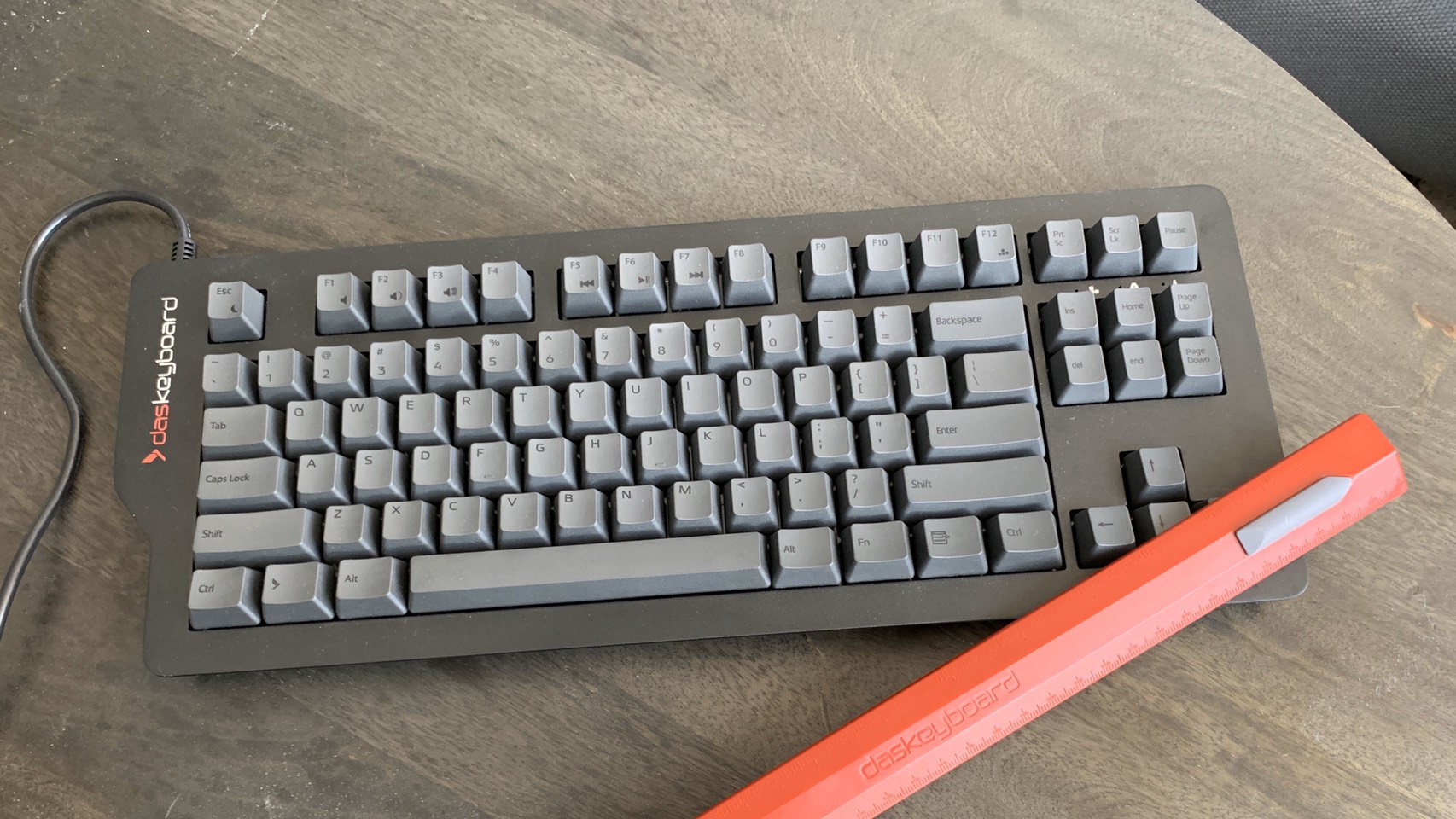
The Das Keyboard 4C TKL isn’t a gaming keyboard, but with its over-$100 price tag and mechanical switches, it’s likely shoppers will consider moonlighting the peripheral as a gaming accessory too. If you like the feel of Cherry MX Brown switches for gaming, then you won't have any problems. However, for me, the tactile bump which is part of the all brown switches made for slower reaction times than the linear, red switches I'm used to.
For example, when playing Overwatch using the 4C TKL, which requires twitchy reactions and frequent use of the WASD keys to move around as well as the Shift and E keys to activate abilities, I felt like I was slower to react than I’ve been on other keyboards. This is because I would often think, “I want to press Shift” or, “I need to press S” while my fingers were still busy depressing other buttons, thanks to the extra force the 4C TKL's Cherry MX Brown switches require over my usual keyboard's Cherry MX Red switches.
We’re only talking fractions of a second in difference here, but it was uncomfortable feeling like my body was reacting slower than I could think. Compared to the light taps that characterize Cherry MX Red keys, the extra effort needed here somewhat threw off my usual rhythm.
My feelings changes during one particular moment of intense overtime action where I earned 6 kills on the enemy team in a row, securing victory for my team. Thanks to the tactile feedback of the 4C TKL’s switches, I was more easily able to concentrate on the game rather than my inputs. This was helpful among the game’s hectic environment and my character Genji’s more complex movement patterns.
Still, after a few more matches, my fingers felt a little tired from the extra force required to activate the MX Brown switches over the MX Red ones I typically use. However, that moment of intense action goes to show how much of a personal preference switch choice is. While I prefer Cherry MX Reds, some gamers love Browns.
I also booted Street Fighter III: 3rd Strike and hopped into training mode with Ryu. Unfortunately, my hopes were immediately crushed, as even pulling off a simple fireball motion- -- down, then right, then the punch button -- was difficult. My key presses were simply too slow to easily enter all three inputs within the short window. Meanwhile, I was able to pull it off on nearly every try with my Corsair, thanks to its fast-actuating Cherry MX Reds.
The 4C TKL's gaming comfort may be more subjective, but the lack of onboard memory for creating profiles, or RGB lighting effects for both style and feedback, does limit its gaming usability.
Features and Software on Das Keyboard 4C TKL
The Das Keyboard 4C TKL keyboard lacks onboard memory, a companion app or backlighting. Aside from typical N-key rollover and Fn-mapped media keys, you get a USB 2.0 hub with two Type-A USB ports. This is perfect for either extending your computer’s connections or easily setting up a mouse without bending over to plug it into your PC.
The chief worry for a hub would be latency, but luckily, I didn’t encounter any on the 4C TKL. Using the website clickspeedtest.com, I tested how many clicks I could get in 5 seconds on a mouse plugged directly into my desktop against one plugged into the 4C TKL’s hub. After 5 tests each, I earned 6.2 clicks-per-second on almost all attempts, with no noticeable difference between the hub and the direct connection. This was also my experience when playing Overwatch, where I felt no discernable difference in input lag whether I was using my best gaming mouse plugged into the hub or my best directly into my gaming PC.
The Das Keyboard 4C TKL’s Fn row has media keys for muting, lowering, and raising the volume, as well as for rewinding, fast forwarding, and pausing video. It also has a game mode that users can activate to disable the Windows key, as well as a command to instantly put your computer to sleep by pressing Fn and the Escape key simultaneously.
The button to the right of the Fn key simulates a right-click. This isn’t uncommon on some keyboards, as the Corsair Vengeance K65 keyboard I’ve been using as my daily driver since 2016 does the same thing. Still, some people might be more accustomed to a second Windows key taking up that slot instead.
Bottom Line
The Das Keyboard 4C TKL is perfect for writers, programmers and other users for whom typing quickly and accurately is a priority. A classy design makes the mechanical a perfect fit for the office. Its Cherry MX Brown switches excel at comfort, stability, and feedback, though can be tiring after a while.
While its lack of dedicated media buttons is a little disappointing, the professional keyboard’s Fn row replicates these functions well enough, and its NKRO rollover functions without issue. The included USB hub is also great for users with plenty of accessories and didn’t show any noticeable input lag during our testing.
While the Das Keyboard 4C TKL will work for games, there are better gaming options for similar or lower prices, like the HyperX x Ducky One 2 Mini.
If you, like many of us, are currently working from a home office, the Das Keyboard 4C TKL can make your setup look more professional with comfortable typing without taking up too much desk space.
MORE: Best Gaming Keyboards
MORE: All Keyboard Content
Michelle Ehrhardt is an editor at Tom's Hardware. She's been following tech since her family got a Gateway running Windows 95, and is now on her third custom-built system. Her work has been published in publications like Paste, The Atlantic, and Kill Screen, just to name a few. She also holds a master's degree in game design from NYU.
-
Findecanor MX Brown is not clicky!Reply
And when did Tom's Hardware start having auto-playing videos?
What has happened to you? -
vbrenny I was also a bit curious about the clicky sound observations.Reply
Maybe it's actually the bottoming-out 'thock'?
It would definitely be a new thing having MX brown switches with any clicking noise.
